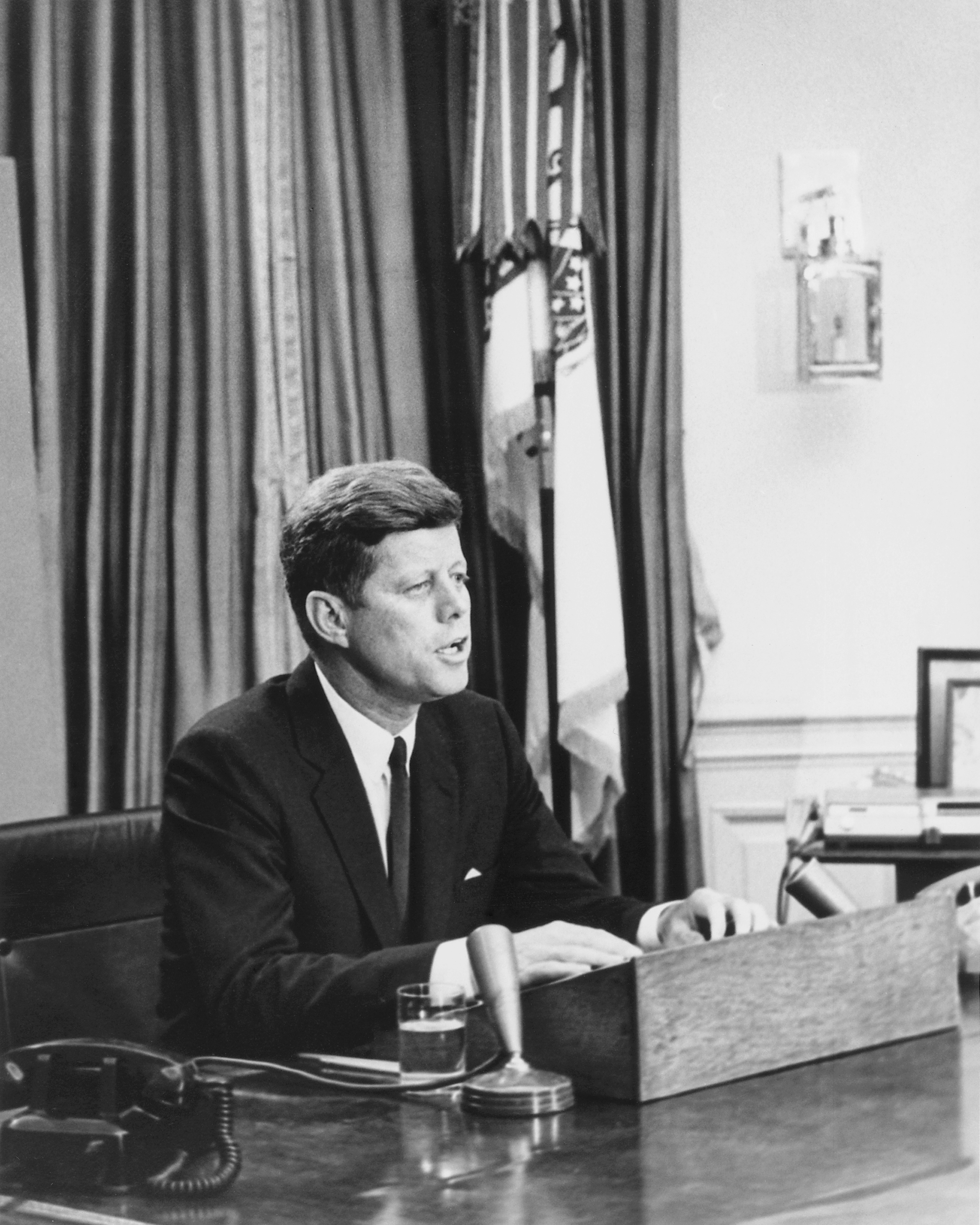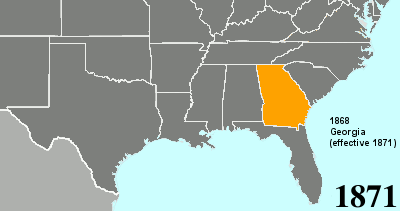|
John Jarman
John Henry Jarman II (July 17, 1915 – January 15, 1982) was a member of the US House of Representatives from Oklahoma for 26 years, from 1951 to 1977. Early life and career Jarman was born in Sallisaw, Oklahoma, on July 17, 1915, and graduated from Yale University in 1937 and from Harvard Law School in 1941. He was admitted to the bar in 1941 and began his law practice in Oklahoma City. Jarman enlisted in the US Army in January 1942, about a month after the Japanese attack on Pearl Harbor. He served in the Security Intelligence Corps during World War II and was discharged from military service in December 1945. He was married Ruth Virginia Bewley and had three children: John Henry Jarman III, Susan Jarman, and Steve Jarman. Jarman was later elected to the Oklahoma House of Representatives and later to the Oklahoma State Senate. Jarman was elected to the US House of Representatives in 1950 as a Democrat. Jarman did not sign the 1956 Southern Manifesto and voted for the Ci ... [...More Info...] [...Related Items...] OR: [Wikipedia] [Google] [Baidu] |
Sallisaw, Oklahoma
Sallisaw is a city and county seat in Sequoyah County, Oklahoma, United States. As of the 2010 Census, it had a population was 8,880, an 11.2 percent increase over the figure of 7,891 recorded in 2000. Sallisaw is part of the Fort Smith, Arkansas–Oklahoma Metropolitan Statistical Area. History French explorers and traders had travelled through this part of North America in the 17th Century, and were the people who attached the name Sallisaw to several geographic features. In the 1840s and 1850s, Sallisaw had been the name of one of the 22 Arkansas River steamboat landings between Fort Smith and Fort Gibson. Modern Sallisaw's beginning as a permanent community began in 1887–1888, when Argyle Quesenbury, a white man, and Will Watie Wheeler, a collateral relative of noted Cherokee leader Stand Watie, laid out lots for a town. Several post offices had existed in the area nearby, even before there was a named community. The site of present-day Sallisaw fell within the boundaries o ... [...More Info...] [...Related Items...] OR: [Wikipedia] [Google] [Baidu] |
US Army
The United States Army (USA) is the land service branch of the United States Armed Forces. It is one of the eight U.S. uniformed services, and is designated as the Army of the United States in the U.S. Constitution.Article II, section 2, clause 1 of the United States Constitution (1789). See alsTitle 10, Subtitle B, Chapter 301, Section 3001 The oldest and most senior branch of the U.S. military in order of precedence, the modern U.S. Army has its roots in the Continental Army, which was formed 14 June 1775 to fight the American Revolutionary War (1775–1783)—before the United States was established as a country. After the Revolutionary War, the Congress of the Confederation created the United States Army on 3 June 1784 to replace the disbanded Continental Army.Library of CongressJournals of the Continental Congress, Volume 27/ref> The United States Army considers itself to be a continuation of the Continental Army, and thus considers its institutional inception to be the o ... [...More Info...] [...Related Items...] OR: [Wikipedia] [Google] [Baidu] |
Party Switching In The United States
In the politics of the United States, party switching is any change in party affiliation of a partisan public figure, usually one who is currently holding elected office. Use of the term "party switch" can also connote a transfer of holding power in an elected governmental body from one party to another. History 19th century The first two major parties in the United States were the Federalist Party and the Democratic-Republican Party. The Federalists experienced success in the 1790s but lost power in the 1800 elections and collapsed after the War of 1812. Many former Federalists, including John Quincy Adams, became members of the Democratic-Republican Party. After the 1824 presidential election, the Democratic-Republicans fractured between supporters of Adams and supporters of Andrew Jackson. Jackson's followers formed the Democratic Party, while those who supported Adams formed the National Republican Party. Two short-lived but significant third parties, the Anti-Masonic Pa ... [...More Info...] [...Related Items...] OR: [Wikipedia] [Google] [Baidu] |
Watergate Scandal
The Watergate scandal was a major political scandal in the United States involving the administration of President Richard Nixon from 1972 to 1974 that led to Nixon's resignation. The scandal stemmed from the Nixon administration's continual attempts to cover up its involvement in the June 17, 1972, break-in of the Democratic National Committee headquarters at the Washington, D.C., Watergate Office Building. After the five perpetrators were arrested, the press and the Justice Department connected the cash found on them at the time to the Committee for the Re-Election of the President. Further investigations, along with revelations during subsequent trials of the burglars, led the House of Representatives to grant the U.S. House Judiciary Committee additional investigative authority—to probe into "certain matters within its jurisdiction", and led the Senate to create the U.S. Senate Watergate Committee, which held hearings. Witnesses testified that Nixon had approved plans t ... [...More Info...] [...Related Items...] OR: [Wikipedia] [Google] [Baidu] |
Harry Truman
Harry S. Truman (May 8, 1884December 26, 1972) was the 33rd president of the United States, serving from 1945 to 1953. A leader of the Democratic Party, he previously served as the 34th vice president from January to April 1945 under Franklin Roosevelt and as a United States senator from Missouri from 1935 to January 1945. Assuming the presidency after Roosevelt's death, Truman implemented the Marshall Plan to rebuild the economy of Western Europe and established both the Truman Doctrine and NATO to contain the expansion of Soviet communism. He proposed numerous liberal domestic reforms, but few were enacted by the conservative coalition that dominated the Congress. Truman grew up in Independence, Missouri, and during World War I fought in France as a captain in the Field Artillery. Returning home, he opened a haberdashery in Kansas City, Missouri, and was elected as a judge of Jackson County in 1922. Truman was elected to the United States Senate from Missouri in 1934. In 1 ... [...More Info...] [...Related Items...] OR: [Wikipedia] [Google] [Baidu] |
Civil Rights Act Of 1968
The Civil Rights Act of 1968 () is a landmark law in the United States signed into law by United States President Lyndon B. Johnson during the King assassination riots. Titles II through VII comprise the Indian Civil Rights Act, which applies to the Native American tribes of the United States and makes many but not all of the guarantees of the U.S. Bill of Rights applicable within the tribes. (that Act appears today in Title 25, sections 1301 to 1303 of the United States Code). Titles VIII and IX are commonly known as the Fair Housing Act, which was meant as a follow-up to the Civil Rights Act of 1964 (this is different legislation than the Housing and Urban Development Act of 1968, which expanded housing funding programs). While the Civil Rights Act of 1866 prohibited discrimination in housing, there were no federal enforcement provisions. The 1968 act expanded on previous acts and prohibited discrimination concerning the sale, rental, and financing of housing based on rac ... [...More Info...] [...Related Items...] OR: [Wikipedia] [Google] [Baidu] |
Civil Rights Act Of 1964
The Civil Rights Act of 1964 () is a landmark civil rights and United States labor law, labor law in the United States that outlaws discrimination based on Race (human categorization), race, Person of color, color, religion, sex, and national origin. It prohibits unequal application of voter registration requirements, racial segregation in schools and public accommodations, and employment discrimination. The act "remains one of the most significant legislative achievements in American history". Initially, powers given to enforce the act were weak, but these were supplemented during later years. Congress asserted its authority to legislate under several different parts of the United States Constitution, principally its power to regulate interstate commerce under Article One of the United States Constitution, Article One (section 8), its duty to guarantee all citizens Equal Protection Clause, equal protection of the laws under the Fourteenth Amendment to the U.S. Constitution, ... [...More Info...] [...Related Items...] OR: [Wikipedia] [Google] [Baidu] |
Civil Rights Act Of 1957
The Civil Rights Act of 1957 was the first federal civil rights legislation passed by the United States Congress since the Civil Rights Act of 1875. The bill was passed by the 85th United States Congress and signed into law by President Dwight D. Eisenhower on September 9, 1957. The Supreme Court of the United States, Supreme Court's 1954 ruling in the case of ''Brown v. Board of Education'' brought the issue of school desegregation to the fore of public attention, as Southern Democratic leaders began a campaign of "massive resistance" against desegregation. In the midst of this campaign, President Eisenhower proposed a civil rights bill designed to provide federal protection for African Americans, African American voting rights; most African Americans in the Southern United States had been Disenfranchisement after the Reconstruction Era, disenfranchised by state and local laws. Though the civil rights bill passed Congress, opponents of the act were able to remove or weaken se ... [...More Info...] [...Related Items...] OR: [Wikipedia] [Google] [Baidu] |
Voting Rights Act Of 1965
The Voting Rights Act of 1965 is a landmark piece of federal legislation in the United States that prohibits racial discrimination in voting. It was signed into law by President Lyndon B. Johnson during the height of the civil rights movement on August 6, 1965, and Congress later amended the Act five times to expand its protections. Designed to enforce the voting rights guaranteed by the Fourteenth and Fifteenth Amendments to the United States Constitution, the Act sought to secure the right to vote for racial minorities throughout the country, especially in the South. According to the U.S. Department of Justice, the Act is considered to be the most effective piece of federal civil rights legislation ever enacted in the country. It is also "one of the most far-reaching pieces of civil rights legislation in U.S. history." The act contains numerous provisions that regulate elections. The act's "general provisions" provide nationwide protections for voting rights. Section 2 is a ... [...More Info...] [...Related Items...] OR: [Wikipedia] [Google] [Baidu] |
Twenty-fourth Amendment To The United States Constitution
The Twenty-fourth Amendment (Amendment XXIV) of the United States Constitution prohibits both Congress and the states from conditioning the right to vote in federal elections on payment of a poll tax or other types of tax. The amendment was proposed by Congress to the states on August 27, 1962, and was ratified by the states on January 23, 1964. Southern states of the former Confederate States of America adopted poll taxes in laws of the late 19th century and new constitutions from 1890 to 1908, after the Democratic Party had generally regained control of state legislatures decades after the end of Reconstruction, as a measure to prevent African Americans and often poor whites (and following passage of the Nineteenth Amendment, women) from voting. Use of the poll taxes by states was held to be constitutional by the Supreme Court of the United States in the 1937 decision ''Breedlove v. Suttles''. When the 24th Amendment was ratified in 1964, five states still retained a po ... [...More Info...] [...Related Items...] OR: [Wikipedia] [Google] [Baidu] |
Civil Rights Act Of 1960
The Civil Rights Act of 1960 () is a United States federal law that established federal inspection of local voter registration polls and introduced penalties for anyone who obstructed someone's attempt to register to vote. It dealt primarily with discriminatory laws and practices in the segregated South, by which African Americans and Mexican-American Texans had been effectively disenfranchised since the late 19th and start of the 20th century. This was the fifth Civil Rights Act to be enacted in United States history. Over an 85-year period, it was preceded only by the Civil Rights Act of 1957, whose shortcomings largely influenced its creation. This law served to more effectively enforce what was set forth in the 1957 act through eliminating certain loopholes in it, and to establish additional provisions. Aside from addressing voting rights, the Civil Rights Act of 1960 also imposed criminal penalties for obstruction of court orders to limit resistance to the Supreme Court ... [...More Info...] [...Related Items...] OR: [Wikipedia] [Google] [Baidu] |
Southern Manifesto
The Declaration of Constitutional Principles (known informally as the Southern Manifesto) was a document written in February and March 1956, during the 84th United States Congress, in opposition to racial integration of public places. The manifesto was signed by 19 US Senators and 82 Representatives from the South. The signatories included the entire Congressional delegations from Alabama, Arkansas, Georgia, Louisiana, Mississippi, South Carolina, and Virginia, most of the members from Florida and North Carolina, and several members from Tennessee and Texas. All of them were from former Confederate states. Ninety-nine were Democrats; two were Republicans. The Manifesto was drafted to counter the landmark Supreme Court 1954 ruling ''Brown v. Board of Education'', which determined that segregation of public schools was unconstitutional. School segregation laws were some of the most enduring and best-known of the Jim Crow laws that characterized the Southern United States at the ... [...More Info...] [...Related Items...] OR: [Wikipedia] [Google] [Baidu] |





